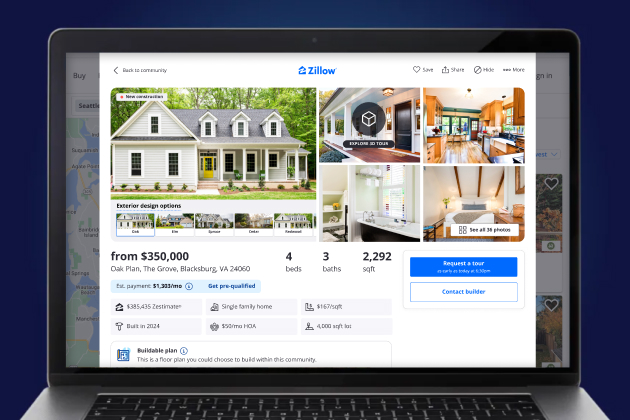The Zestimate Explained for New Construction

August 3, 2018
6 min read
Love it or hate it, the Zestimate® home valuation is a tool that adds value to a buyer in their search for a home. But builders and buyers alike might wonder how the Zestimate applies to new construction. After all, if it’s based in part on past sales records, how does Zillow create an accurate Zestimate for a brand new home?
The first step in explaining to prospective buyers how Zillow arrived at the Zestimate for a new construction home is to learn what the Zestimate is and how it’s made. Here’s a guide to help you understand how we do that.
What is the Zestimate?
The Zestimate is an estimate of the value of the home given today’s housing market. It’s crafted by a complex, ever-evolving series of data models designed by economists, mathematicians, statisticians and computer scientists at Zillow. Calculating the Zestimate is neither sorcery nor ad hoc: It’s a sophisticated process that focuses on hard data from many sources, including public records, multiple listing services (MLS), and broker- and homeowner-submitted data, and — as of summer 2019 — the use of real-time data and computer vision to identify and value features of individual homes. The Zestimate combines artificial intelligence and other advanced technologies such as computer vision and a deep-learning-based neural network and this hard data about homes with recent sales of similar homes to arrive at its valuation.
The Zestimate is not an official appraisal, nor should it replace an inspection or walkthrough. Instead, it’s a starting point in the sometimes long process of uncovering how much a home is worth in current local market conditions.
What that means for new construction
Understanding how the Zestimate is calculated and using the Zestimate Value Range as a starting point can be a useful tool for helping builders identify the right price range for a newly constructed home or neighborhood.
How is the Zestimate calculated?
Due to changing market conditions, tax assessments and other factors that impact housing, the recipe for the Zestimate is constantly evolving. The main, ever-present ingredient is data, broken down into these categories:
- Physical attributes of homes — sourced from public records, MLSs and brokers, and homeowner-submitted data — including location, square footage, lot size, number of bedrooms and bathrooms, and other details.
- Tax assessments and other tax assessor information.
- Past sale records for the home itself and nearby or comparable homes. Obviously, for new construction, the Zestimate solely relies on the latter.
- Real-time data from for-sale homes, including list price and how long a home has been on the market.
- Photos — using neural networks and computer vision, it can distinguish between high and low-end finishes and to incorporate the value of features like updated bathroom fixtures, fireplaces, and kitchens. It can, in a sense, "see" in photographs features that humans would instantly understand, such as curb appeal and natural light.
Zillow’s data scientists run the data through a series of proprietary economic models to calculate the Zestimate and the Zestimate Value Range, which shows the high and low estimated values of a home. The data produced by the proprietary economic models is continuously analyzed and compared with real home sale prices, which causes the Zestimate model to change and improve over time.
What that means for new construction
Newly constructed homes can pose two challenges for the Zestimate. The first is that there is less information readily available about the newly constructed home to use in the valuation. For example, with a teardown and rebuild home, any previous sales and tax valuation available must be thrown out.
Second, for homes constructed in new communities, the best comparable homes are the other new homes in the community, and there may not be a set of similar homes in nearby pre-existing housing. So, until a few sales have been incorporated into Zillow’s data from that community, the set of comparable homes can be limited and imperfect.
How accurate is the Zestimate?
The Zestimate’s accuracy partly depends on the amount of home information available in a given area. If your county provides robust, detailed data on homes such as home size and sold transaction information, then the Zestimate will be more accurate. Similarly, the more homes that are selling in your area, the more recent comparable homes will be available to calculate a Zestimate from, and accuracy will improve.
Nationally, the Zestimate error rate is less than 2% as of June 2019, meaning half of all Zestimates fall within 2 percent of the home's eventual sale price. This means that half of all homes had a sale price that was within 2 percent of the Zestimate and half had a sale price that was more than 2 percent away from it.
Keep in mind that the Zestimate may be less accurate for market segments with lower transaction volumes or for homes that are unique. For example, homes in luxury markets face the problem of having many custom and community features that aren’t accounted for in the Zestimate model.
What that means for new construction
The Zestimate may be less accurate in new communities where fewer new construction homes have been completed or sold and where the neighborhood isn’t entirely developed.
Can the Zestimate be updated?

Yes. The Zestimate model gets most home information from public records, but these records can sometimes be limited, outdated or flat-out wrong. In these cases, builders or homeowners can make corrections to their home’s facts on Zillow. These updates can be significant enough to change a home’s Zestimate. The changes driven by home-fact updates typically take about two months to reach their full impact.
What that means for new construction
To improve Zestimate accuracy, builders should keep their home facts up to date on Zillow and include as many photos — whether real or high-quality renderings — of the home as possible.
What is the Zestimate forecast?
The Zestimate forecast is Zillow’s prediction of a home’s Zestimate one year from now, and it appears on the home’s Zillow page next to the Zestimate and Zestimate Value Range. Keep in mind that economic forecasts are attempts to predict the future, which is impossible to do perfectly. That said, data from housing indicators and other general economic indicators can certainly help estimate future home values to some extent.
The Zestimate forecast model uses a number of housing indicators such as mortgage interest rates and property tax rates as well as economic indicators such as population growth.
An individual property’s characteristics, including its features and past sales behavior, can also affect the Zestimate forecast. You can find more in-depth information about the Zestimate forecast accuracy and methodology here.
What that means for new construction
Again, since the Zestimate forecast model is based in part on public records and user-submitted data, it’s more accurate when builders regularly update their home facts whenever they complete houses and communities.
As a housing and real estate professional, you’re constantly educating prospective buyers so they can make the best home decisions for themselves. The Zestimate is another opportunity to do that, and Zillow Group continues to improve the Zestimate’s accuracy to provide builders and buyers with the best information.
Hungry for more specific stats on your local area? Binge on Zillow’s data coverage and Zestimate accuracy table. You can also check out the even larger, all-encompassing home data feast the Zillow analytics team serves up free of charge.
Builders, meet buyers.
82 percent of prospective buyers consider new construction.* Make it easy for them to find you – list where they’re looking.
*Zillow New Construction Consumer Housing Trends Report 2025
Learn More